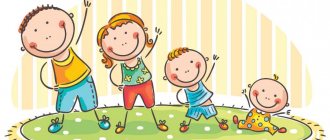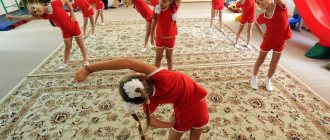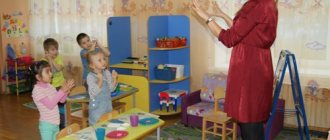Summary of morning exercises in the 2nd junior group on the topic: Autumn
Summary of morning exercises in the second junior group of preschool educational institutions
Topic : “Walk in the autumn forest.” Goal: Continue to train children in rhythmic walking, strengthen large muscle groups, develop muscle strength, joint mobility, form correct posture and the ability to navigate in space. Maintain interest in doing exercises, develop dexterity, endurance, and bring joy and pleasure to children. 1. Formation in a line. Educator: The wind is blowing, blowing, blowing, blowing. The yellow leaves are torn from the tree. - When does this happen? Children: In autumn. Educator: What time of year is it now? Children: Autumn. Educator: I suggest you take a walk through the autumn forest, play with autumn leaves. They turned to follow the leader and everyone went into the autumn forest. (Walking, running in alternation 2 times). Educator: Don’t scare away the animals living in the forest. We walk carefully, on our toes, arms straight above our heads, stretching upward, growing. (Walking on toes, normal walking) The grass is tall, we walk, raising our legs high at the knees, hands on our belts. (Walking, raising your legs high at the knees, normal walking) Like there are many bumps in the forest, let’s jump forward from bump to bump, hands on our belts. (Jumping forward, normal walking) Stand in an even circle. (Building in a circle). 2. General developmental exercises with leaves. (The leaves are arranged in a circle.) Educator: Look at the beautiful maple leaves that fell to the ground. Let's take them and play with them. (Children take leaves). 1). "Let's wave the leaves." I.p. – legs hip-width apart, arms with leaves along the body. Raising our hands forward - up, we wave the leaves above our heads, lowering our hands down, etc. (4-5 times) 2). “The wind blows, the trees sway.” I.p. – feet shoulder-width apart, arms along the body. Raising our arms up from the sides, we sway left and right “strong, weak wind” (Swings left and right at different tempos) (5 times). 3). "Let's hide behind the leaves." I.p. – heels together, toes apart, hands with leaves behind your back. Squatting, we bring our hands with the leaves forward, hiding our face behind the leaves; taking i.p. We say: “Here we are!” The back is straight. (5-6 times) 4). “Let’s show the leaves.” I.p. - kneeling, hands with leaves behind your back. We bring our hands with the leaves forward, show them the leaves and say: “here.” Back straight, arms straight. 5). "Let's dance with the leaves." I.p. – kneeling, hands with leaves along the body. Light springs (3-4 times) lift the leaves up from the sides up above your head, spin around. Repeat 3-4 times. 6). Breathing exercise: “Let’s blow on the leaves.” Inhale air through your nose, exhale through your mouth: blow on the leaves. 3. (The teacher blows on the children’s leaves) The breeze blew, and the leaves flew in different directions (light running in all directions) The wind became quieter and quieter. (Walking behind the leader.) That's how many beautiful leaves we collected in the forest.
We recommend watching:
Summary of a lesson on speech development for the 2nd junior group. Pleshcheev “Autumn” Summary of OOD in the junior group with presentation. A Journey to the Autumn Forest Notes on social and communicative development in the 2nd junior group on the topic: Autumn Notes on social and communicative development in the 2nd junior group on the topic “Autumn has come to us”
Similar articles:
Complex of morning exercises for schoolchildren and teenagers
Lesson notes for the younger group. Broken applique “Autumn leaves”
Gender communication between girls and boys in preschool age
Brief description of the document:
Ministry of Education, Science and Youth Policy of the Nizhny Novgorod Region State Autonomous Professional Educational Institution “Gorodetsky Provincial College” Report on the topic: “Gender communication between girls and boys in preschool age” Completed by: Shutova Ekaterina Student of group 313 G. Gorodets, 2021 Gender education - an individual approach to the expression of a child own identity, which in the future gives a person greater freedom of choice and self-realization, helps to be flexible enough and be able to use different possibilities of behavior. The goal of the gender approach is to raise children of different sexes who are equally capable of self-realization and revealing their potentials and capabilities in modern society. Gender socialization includes three aspects: cognitive - the child early begins to identify himself as a certain gender, acquires ideas about the content of typical role behavior (D. N. Isaev, V. E. Kagan, I. S. Kon, T. A. Repina ); emotional - gender-role preferences, interests, value orientations, reactions to assessment, manifestation of emotions associated with the formation of the traits of a man (boy) and a woman (girl) (D. V. Kolesov, A. E. Olshannikova, N. B. Selverova, T. P. Khrizman); behavioral – the assimilation of a gender-typical behavior model (I. S. Kon, D. V. Kolesov, N. V. Plisenko, T. A. Repina). There are several main directions and aspects of gender education in preschool educational institutions: Thematic conversations. Children can look for each other's commonalities and differences, discuss what it means to be a girl, what it means to be a boy, and so on. Games with gender roles. Girls want to be ballerinas and actresses, boys want to be pilots and programmers. Girls like to dress up dolls in dresses, boys like to line up soldiers on the edge of the table and crush an imaginary enemy. Reading fairy tales, word games, acting out skits and other ways to create associations with characters of the same gender. A girl who has no problems with gender self-identification will associate herself with Mashenka, a kitty, a fox, and so on. The boy is with Petya, the prince, the bear, etc. And the point here is not in attributing to oneself the characteristics of the character, but, for example, in acting out his role in the scene. A competent approach to conducting physical education classes. But in the early years, in a kindergarten, such a division by type of exercise is most justified both in the context of the characteristics of the physical development of girls and boys, and in connection with the needs of their gender education. Proper distribution of tasks when conducting dance classes, matinees, and organizing performances. So, if we are talking about dancing, then girls should perform smooth and soft movements, while boys can set the rhythm and lead their little partners. You may have heard about an experiment in the second half of the twentieth century, when a boy named Bruce, who was unsuccessfully circumcised, was decided to be castrated completely and raised as a girl, Brenda. The author of this experiment, John Money, wanted to prove that the behavioral characteristics of men and women depend solely on their upbringing, on what they are taught to do from early childhood. Despite everything, Brenda, born Bruce, behaved like a typical boy , and even giving him/her estrogen did not help. This unfortunate man refused sex reassignment surgery, tried to commit suicide three times, and at the age of 32 he regained his male sexual characteristics and started a family. However, after the divorce, he still committed suicide at the age of 38. Since then, many studies have been conducted that clearly prove that the differences between men and women are not only in physiology, but also in the characteristics of higher nervous activity, in the functioning of the psyche, in behavior, etc. Despite all of the above, it is important to understand that each child is a unique person, with his own distinct personality, and kindergarten teachers should also understand this. Therefore, although the relevance of gender education for adequate parents is beyond doubt, it is important to approach it very carefully and take into account a number of nuances: Children may like things that do not correspond to the classic scenario for the development of their gender. Modern society fully allows women to work as engineers and men as dancers. Therefore, if your daughter hates dolls and prefers cars to them, or if your boy likes to braid your hair rather than play war games, so be it. This does not mean at all that you will raise a child of non-traditional sexual orientation. Violence is never an option in parenting, and statements like “don’t act like a fag” can only help develop a child’s thoughts in ways they would never consider on their own. Children have a right to their own character and temperament. A choleric girl will always be more lively and active than a melancholic boy. Temperament is something that is given to a baby from birth, something he cannot change, and something he can only adapt to in order to achieve his goals in a way that is convenient for him. Don't ask a girl to act like a little princess, or a boy to act like a little soldier. Don't make your child feel wrong because his character doesn't conform to common expectations of how he should behave. Otherwise, the baby will only withdraw into himself. This point will probably be the least of your liking, but the current state of affairs forces us to mention it. From a physiological point of view, due to a lack or excess of certain hormones at a certain stage of pregnancy, your child could theoretically, although with a very small probability, be born with sexual behavior disorders. This small probability, according to some researchers, amounts to several percent, according to others - several tenths of a percent. However, such deviations appear more likely in adolescence. Moreover: if your child refuses his gender role and demonstrates a tendency towards homosexuality, it would not be a bad idea to take him to a consultation with a good psychologist. In conditions when same-sex relationships are almost popularized on TV and on the Internet, many children in puberty think about this topic only in the format of some kind of experiment, although in fact they have no inclinations towards it. However, as already mentioned, if such a problem and the need to put up with it arises, it will be much later than in preschool age. So, gender education in a kindergarten is an important and quite feasible task, but, as in any issues related to the education of the younger generation, it is very important to find and maintain a middle ground. Love your children, help them find the right path in life, but don’t stop them from being themselves - they deserve your warmth and support, regardless of their character traits!



